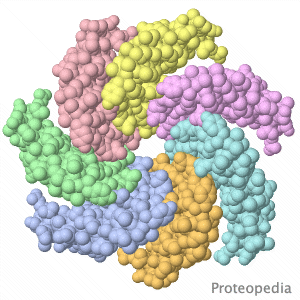Proteopedia:Featured EDU/9
From Proteopedia
(Difference between revisions)
(New page: <table> <tr><td> <imagemap> Image:7pmx-y-morph-trace.gif|center default Drug and peptide transport in humans </imagemap> </td></tr> <tr><td><div class="scrolling">'''You Are What You E...) |
|||
| (3 intermediate revisions not shown.) | |||
| Line 2: | Line 2: | ||
<tr><td> | <tr><td> | ||
<imagemap> | <imagemap> | ||
| - | Image: | + | Image:2vv5-2oau-morf-mechanosensitive-channel.gif|center |
| - | default [[ | + | default [[Mechanosensitive channels: opening and closing]] |
</imagemap> | </imagemap> | ||
</td></tr> | </td></tr> | ||
| - | <tr><td><div class="scrolling">''' | + | <tr><td><div class="scrolling">'''Touch-Sensitive Channel'''<br> |
| - | + | Touching stretches cell membranes, opening mechanosensitive ion channels, leading to sensation by the nervous system. | |
| - | + | Pictured is the transmembrane region of a similar channel in bacteria. When closed, the narrow opening is lined by hydrophobic | |
| - | + | amino acid sidechains, making it non-conductive to ions. | |
| - | + | ||
| - | + | ||
| - | >>> [[ | + | >>> [[Mechanosensitive channels: opening and closing|See more animations and explanation]] >>> |
</div> | </div> | ||
</td></tr> | </td></tr> | ||
Current revision
Touch-Sensitive Channel
Touching stretches cell membranes, opening mechanosensitive ion channels, leading to sensation by the nervous system. Pictured is the transmembrane region of a similar channel in bacteria. When closed, the narrow opening is lined by hydrophobic amino acid sidechains, making it non-conductive to ions. |


